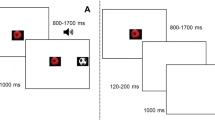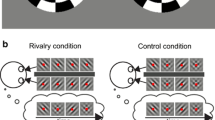Abstract
The attentional blink paradigm tests attention by overloading it: a list of stimuli is presented very rapidly one after another at the same location on a computer screen, each item overwriting the last, and participants monitor the list using two criteria [e.g. detect the target (red letter) and identify the probe (letter p)]. If the interval between the target and the probe is greater than about 500 ms, both are usually reported correctly, but, when the interval between the target and the probe is within 200–500 ms, report of the probe declines. This decline is the attentional blink, an interval of time when attention is supposedly switching from the first criterion to the second.
The attentional blink paradigm should be difficult to perform correctly without vigilantly attending to the rapidly presented list. Vigilance tasks are often used to assess attention-deficit hyperactivity disorder (ADHD). Symptoms of the disorder include hyperactivity and attentional dysfunction; however, some people with ADHD also have difficulty maintaining gaze at a fixed location. We tested 15 adults with ADHD and their age- and sex-matched controls, measuring accuracy and gaze stability during the attentional blink task. ADHD participants reported fewer targets and probes, took longer to recover from the attentional blink, made more eye movements, and made identification errors consistent with non-perception of the letter list. In contrast, errors made by control participants were consistent with guessing (i.e., report of a letter immediately preceding or succeeding the correct letter). Excessive eye movements result in poorer performance for all participants; however, error patterns confirm that the weak performance of ADHD participants may be related to gaze instability as well as to attentional dysfunction.








Similar content being viewed by others
References
Barkley RA (1990) Attention-deficit hyperactivity disorder: a handbook for diagnosis and treatment. Guilford, New York
Barkley RA (1997) ADHD and the nature of self-control. Guilford, New York
Brehaut JC, Enns JT, DiLollo V (1999) Visual masking plays two roles in the attentional blink. Percept Psychophys 61:1436–1448
Brown TE (1996) Brown ADD scales. Psychological Corporation, San Antonio, TX
Connolly JD, Goodale MA, Menon RS, Munoz DP (2002) fMRI evidence for the neural correlates of preparatory set in the human. Nat Neurosci 12:1345–1352
Duncan J, Ward R, Shapiro K (1994) Direct measurement of attentional dwell time in human vision. Nature 369:313–315
Fischer B, Hartnegg K (2000) Effects of visual training on saccade control in dyslexia. Perception 29:531–542
Hollingsworth DE, McAuliffe SP, Knowlton BJ (2001) Temporal allocation of visual attention in adult attention deficit hyperactivity disorder. J Cogn Neurosci 13:298–305
Jolicoeur P (1999) Concurrent response-selection demands modulate the attentional blink. J Exp Psychol Hum 25:1097–1113
Jolicoeur P, Dell'Acqua R (2000) Selective influence of second target exposure duration and Task(1) load effects in the attentional blink phenomenon. Psych Bull Rev 7:472–479
Marois R, Chun MM, Gore JC (2000) Neural correlates of the attentional blink. Neuron 28:299–308
Mehta MA, Owen AM, Sahakian BJ, Mavaddat N, Pickard JD, Robbins TW (2000) Methylphenidate enhances working memory by modulating discrete frontal and parietal lobe regions in the human brain. J Neurosci 20:65–13
Moroni C, Boucart M, Humphreys GW, Henaff MA, Belin C (2000) Failure to identify the target does not prevent the attentional blink effect. Neuroreport 11:2775–2780
Munoz DP, Hampton KA, Moore KD, Goldring JE (1999) Control of purposive saccadic eye movements and visual fixation in children with attention-deficit hyperactivity disorder. In: Becker W, Duebel H, Mergner T (eds) Current oculomotor research: physiological and psychological aspects. Kluwer Academic/Plenum, New York, pp 415–423
Munoz DP, Armstrong IT, Hampton KA, Moore KD (2003) Altered control of visual fixation and saccadic eye movements in attention deficit hyperactivity disorder. J Neurophysiol (in press)
Peterson MS, Juola JF (2000) Evidence for distinct bottlenecks in attention switching and attentional blink tasks. J Gen Psychol 127:6–26
Quay HC, Werry JS (1986) Psychopathological disorders of childhood, 3rd edn. Wiley and Sons, New York
Raymond JE, Shapiro KL, Arnell KM (1992) The role of post-target stimulation in producing attentional blinks in rsvp. Int J Psychol 27:44–44
Ross NE, Jolicoeur P (1999) Attentional blink for color. J Exp Psychol Human 25:1483–1494
Rubia K, Overmeyer S, Taylor E, Brammer M, Williams SCR, Simmons A, Bullmore ET (1999) Hypofrontality in attention deficit hyperactivity disorder during higher-order motor control: a study with functional MRI. Am J Psychiatry 156:891–896
Schachar R, Logan G (1990) Are hyperactive children deficient in attentional capacity? J Abnorm Child Psychol 18:493–513
Shapiro KL, Raymond JE (1994) Temporal allocation of visual attention: inhibition or interference? In: Dagenbach D, Carr TH (eds) Inhibitory processes in attention, memory, and language. Academic, New York, pp 151–188
Shapiro KL, Raymond JE, Arnell KM (1994) Attention to visual-pattern information produces the attentional blink in rapid serial visual presentation. J Exp Psychol Hum 20:357–371
Acknowledgements
We thank Dr. Deb Thompson for psychometric testing. This work was supported by an EJLB Foundation research scholar grant to D.P.M. D.P.M holds a Canada Research Chair in Neuroscience.
Author information
Authors and Affiliations
Corresponding author
Rights and permissions
About this article
Cite this article
Armstrong, I.T., Munoz, D.P. Attentional blink in adults with attention-deficit hyperactivity disorder. Exp Brain Res 152, 243–250 (2003). https://doi.org/10.1007/s00221-003-1535-0
Received:
Accepted:
Published:
Issue Date:
DOI: https://doi.org/10.1007/s00221-003-1535-0




